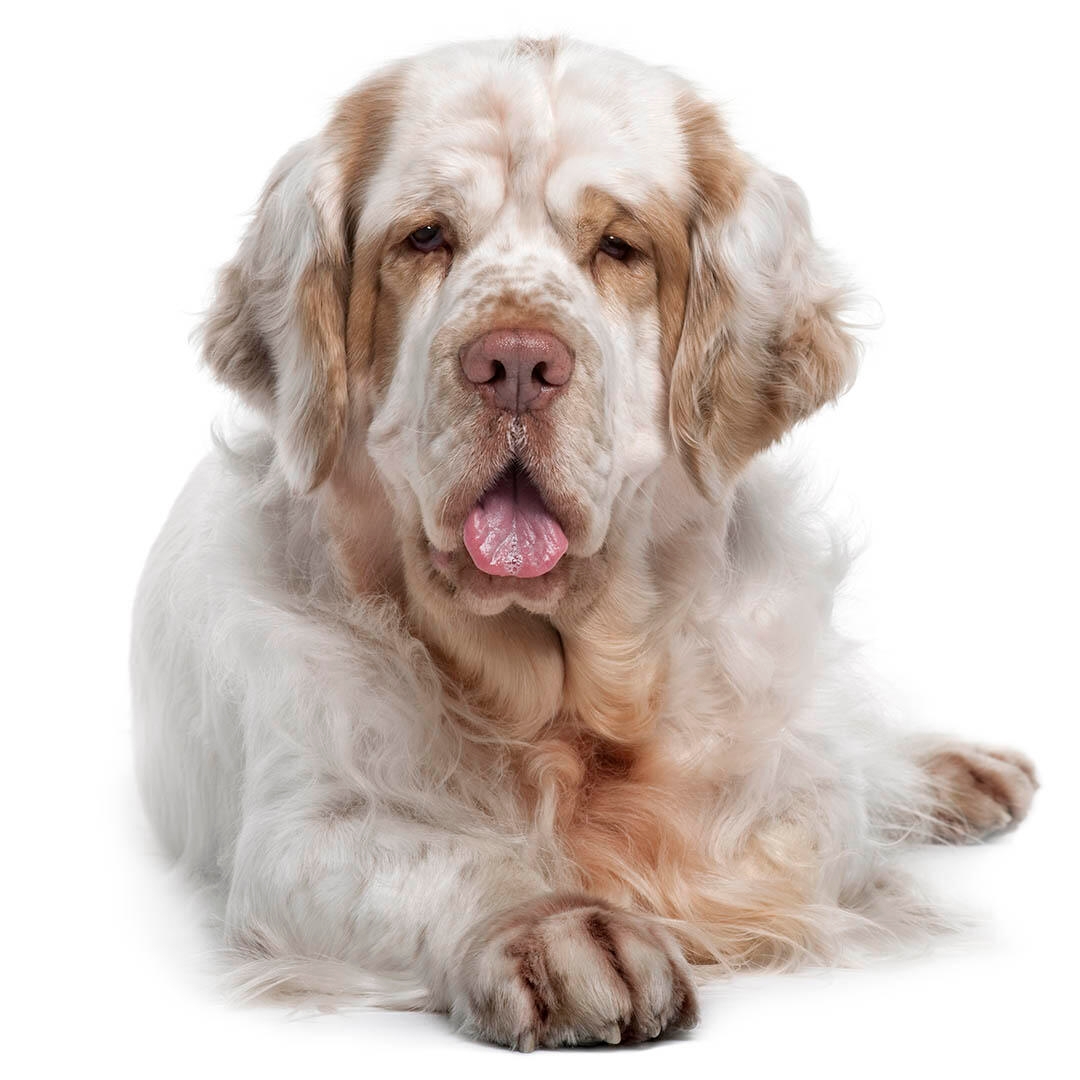
| Family-friendly: | 4/5 |
| Exercise needs: | 2/5 |
| Easy to train: | 4/5 |
| Tolerates being alone: | 2/5 |
| Likes other pets: | 4/5 |
| Energy level: | 3/5 |
| Grooming needs: | 4/5 |
| Shedding: | 5/5 |
As with many breeds, the Clumber Spaniel can suffer from:
- Hip dysplasia
- Elbow dysplasia
- Exercise-induced collapse which is a condition that can cause problems with nerve communication during exercise and can result in collapse.
- Entropion which is a painful eye condition where the eyelids role inwards.
- Keratoconjunctivitis sicca (dry eye) which is a painful condition where the tear gland stops working properly.
Priority Kennel Club health schemes and testing:
- Hip dysplasia screening scheme
- DNA test for Exercise Induced Collapse which tests whether or not a dog has the potential to be affected by this condition.
The Clumber Spaniel being heavier built is slower to mature than other spaniels and generally steadier all round. They are a good natured, affable breed, dignified yet amusing and willing to do whatever task you take the time to teach them.
As happy on the sofa as they are following a scent, the Clumber makes a devoted family dog.
| Family-friendly: | 4/5 |
| Exercise needs: | 2/5 |
| Easy to train: | 4/5 |
| Tolerates being alone: | 2/5 |
| Likes other pets: | 4/5 |
| Energy level: | 3/5 |
| Grooming needs: | 4/5 |
| Shedding: | 5/5 |
The Clumber Spaniel is another breed with somewhat vague romanticised origins involving French nobility, English Dukes and revolutions, however there is little evidence to support such ideas.
The breed does owe their existence to the Duke of Newcastle and their name comes from his estate, Clumber Park where the Duke created his own particular type of heavy, steady Spaniel from the various hunting dogs available at the time. These may have included dogs imported from France, where notably, longer haired low slung ‘basset’ types were popular as these allowed huntsmen on foot to follow them without the need for horses.
For those who love a big dog, but like the soft spaniel nature and prefer a more thoughtful, slower moving breed, the Clumber could be your dog. They’ll still need plenty of training and exercise, but this is a steady, sensible breed, ideal for families with older children. Only suitable for those who can cope with drool and muddy wet paws though!
A strong, reliable recall is vital for off lead exercise, as whilst they are a slower moving Spaniel, they have considerable stamina and perseverance. Around an hour’s exercise per day with plenty of opportunity to enjoy finding scent and using their impressive nose will keep the Clumber Spaniel happy.
The Clumber is a large dog on short legs, and this must be kept in mind when housing and buying equipment. Everything will be drooled on and coated in white hair! As with all low-slung dogs, whilst the Clumber Spaniel dries quickly and is easily brushed off, a sizeable quantity of mud and water can be gathered on paws and undercarriage. Suitable space to allow the Clumber to dry off after walks is necessary, but otherwise they are not hard to house. Providing a variety of interesting walks can be offered, the Clumber Spaniel can be happy in country or leafy suburb.
Large breed dogs, as well as having large appetites, benefit from a different balance of nutrients including minerals and vitamins compared to smaller-breed dogs.
The abundant coat is silky and straight, and there is longer hair (feathering) on the legs and chest that will tangle if neglected. Their coat is easy to maintain with regular weekly brushing, but do watch out for the slobber and the shedding! The feet should be checked daily for grass seeds and trimmed to prevent hair knotting, and the ears should be checked regularly. As with all low-slung dogs, whilst the Clumber Spaniel dries quickly and is easily brushed off, a sizeable quantity of mud and water can be gathered on paws and undercarriage.
The Clumber Spaniel can be trained to a variety of activities and sports, particularly anything scent based, just remember they will do them at a slower, steadier pace than others. With the right understanding of what motivates him, and a ‘working together’ approach, the Clumber is easy to train and fun to spend time with.
Teaching a recall is vital as the Clumbers excellent nose can otherwise lead him into trouble. As with all breeds who like to carry objects in their mouths, teaching a retrieve and swap game from a young age is important.
The Clumber Spaniel is a steady and dependable character once adult; puppies of course can be more enthusiastic. As adults, this is a heavy breed so care should be taken with small children, those frail or unsteady on their feet and of course with smaller pets.
While many dogs are traditionally thought of as being good with children, all dogs and children need to be taught to get on with and respect each other, and be safe together. Even so, dogs and young children should never be left alone together and adults should supervise all interactions between them.